Ever wondered how to transform your home into a peaceful sanctuary that balances style and simplicity? Japandi interior design has taken the decorating world by storm, blending the minimalistic elegance of Japanese aesthetics with the cozy warmth of Scandinavian decor. Its popularity lies in its ability to create spaces that feel both serene and functional, helping you escape clutter and embrace calm in your everyday life.
In this article, you’ll find a treasure trove of inspiring ideas and practical tips to bring Japandi’s tranquil charm into your home. From clever storage solutions to soothing color palettes, sleek furniture, and natural textures, each concept is designed to enhance serenity while keeping clutter at bay.
Whether you’re looking to refresh a single room or reimagine your entire space, these diverse ideas will empower you to craft a beautifully balanced, clutter-free environment that radiates peace and purpose. A clutter-free space is the cornerstone of serene Japandi interiors, and hidden storage solutions are the secret weapon to achieving this effortlessly.
They allow you to keep everyday essentials out of sight, maintaining the minimalist aesthetic that’s so essential to this style. Imagine sleek, built-in cabinets with handleless doors blending seamlessly into the wall, or under-bed drawers in soft, neutral tones that tuck away seasonal clothing or extra linens.
Concealed shelves behind sliding panels can hide books or decorative objects, creating a streamlined silhouette. These storage options keep surfaces clear, so your space feels open and calming, while also reducing visual noise.
The overall effect is a room that feels organized, tranquil, and thoughtfully curated, with every item in its designated place. To implement this, start by assessing your storage needs and choosing furniture with integrated compartments.
Look for options like a low-profile storage ottoman or a bed with built-in drawers for bedrooms, or install concealed wall cabinets in living areas. Simple DIY projects, such as adding hiding compartments behind existing cabinetry, can also work well.
Use neutral or natural wood finishes to match your decor, and keep hardware minimal or invisible for a seamless look. This approach transforms cluttered spaces into peaceful retreats with minimal effort.
1. Use Neutral Color Palettes to Create Calm and Cohesion
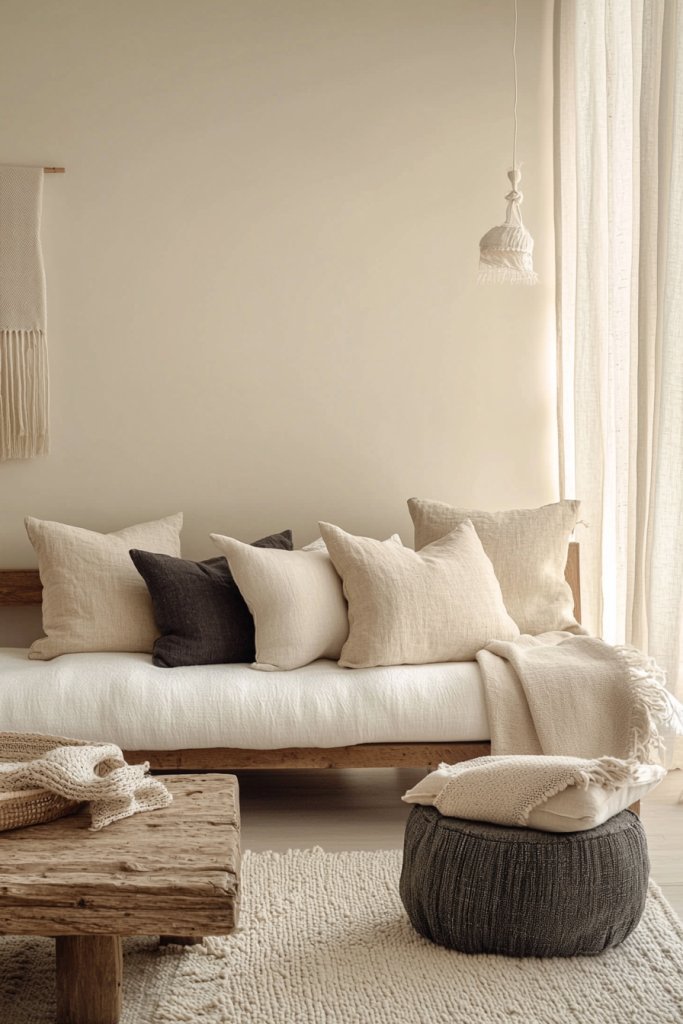
In Japandi design, the power of a neutral color palette lies in its ability to evoke calmness and create visual harmony. Soft, earthy tones like warm beiges, gentle grays, and muted browns serve as the perfect backdrop for a serene oasis.
Picture a living room painted in a soothing off-white with accents in warm taupe and subtle charcoal. The furniture features natural wood finishes, and textiles like linen cushions and wool throws in shades of cream and sand add warmth.
These colors work together to foster a sense of peace, making the space feel balanced and cohesive. The absence of loud hues directs focus to textures and materials, encouraging relaxation and mindfulness.
This palette also enhances natural light, making the room feel brighter and more expansive. To achieve this look, select wall paints in shades like oatmeal, stone gray, or clay.
Incorporate textiles and decor in similarly muted tones, avoiding overly bright or contrasting colors. Use natural materials such as bamboo, raw wood, and cotton to add depth and tactile interest. Keep accessories minimal, focusing on quality over quantity, and let the subtle color variations create a harmonious, clutter-free environment that calms the mind and restores balance.
2. Choose Minimalist Furniture with Simple, Clean Lines

The essence of Japandi style is understated elegance, which shines through in furniture that features minimalist design with clean, straight lines. These pieces serve both form and function, creating a space that feels open, organized, and inviting.
Envision a sleek, low-profile sofa with a slim wooden frame, upholstered in a soft, neutral fabric like linen or cotton. Pair it with a simple, rectangular coffee table made from light wood or matte black metal.
Bed frames are low-slung with unobtrusive headboards, and dining tables are straightforward with smooth, unadorned surfaces. These furniture choices avoid ornate details, emphasizing simplicity and craftsmanship.
Their understated presence allows other elements—like textured textiles or sculptural decor—to stand out without cluttering the visual field, producing a calming, balanced environment. To incorporate minimalist furniture, look for scandinavian-inspired designs from brands like Muji or IKEA, which emphasize functionality and clean aesthetics.
Opt for pieces with smooth surfaces, slender legs, and neutral tones. Consider multipurpose furniture such as a storage bench or a fold-away desk to maximize space efficiency.
Keep the arrangement uncluttered, and choose quality materials like light oak or bamboo to elevate the minimalist look. This approach ensures your space remains serene, functional, and inherently beautiful.
3. Implement Open Shelving for Thoughtful Display and Organization
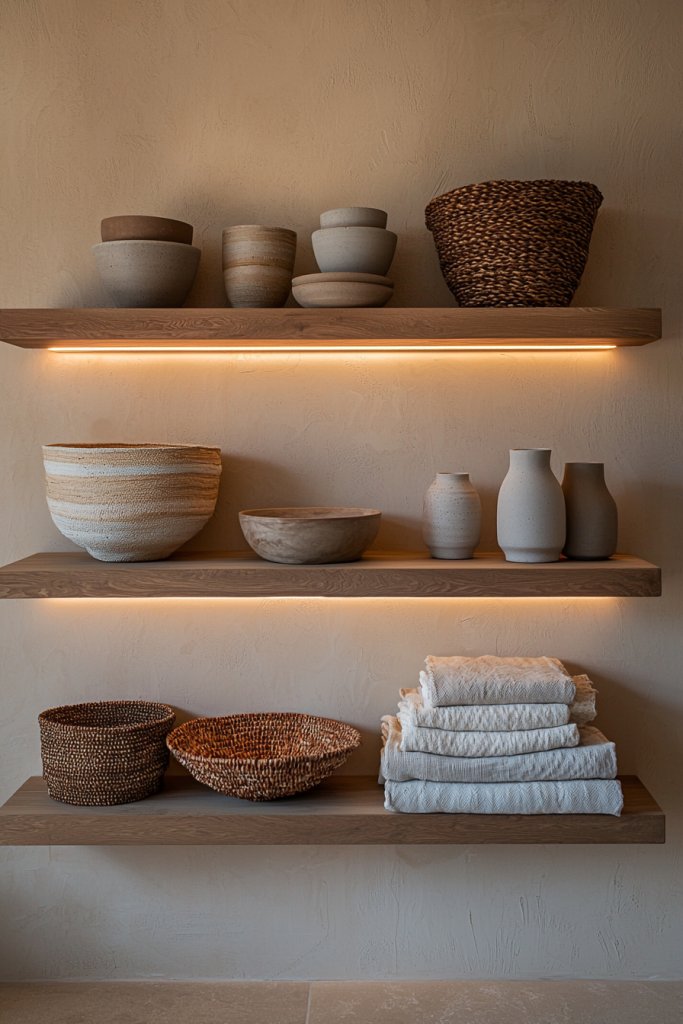
Open shelving is an effective way to combine practicality and aesthetic appeal in Japandi interiors, allowing for organized displays that add personality without disrupting the calm vibe. When curated mindfully, open shelves can showcase meaningful objects and keep everyday essentials within reach.
Visualize floating wooden shelves mounted on a neutral-toned wall, displaying a selection of ceramic bowls, woven baskets, and neatly folded textiles. The key is to keep clutter at bay—select a few well-chosen items like minimalist sculptures, textured vases, or handcrafted ceramics in muted colors.
The open design encourages a sense of openness and accessibility while maintaining a clean look. Proper lighting, such as subtle LED strips or wall-mounted sconces, highlights the display and creates a warm, inviting atmosphere.
The result is a space that feels both thoughtfully curated and effortlessly uncluttered, emphasizing simplicity and beauty. To implement, start with durable, natural wood shelves—think light oak or bamboo—mounted with concealed brackets for a seamless appearance.
Keep the display minimal, rotating items seasonally or as your style evolves. Use baskets or small boxes to hide less attractive or loose items, maintaining order.
When choosing decor, prioritize handcrafted or textured objects in neutral shades, ensuring each piece contributes to the overall peaceful aesthetic. This balanced approach makes open shelving a practical yet beautiful feature in your Japandi home.
4. Opt for Multi-Functional Furniture to Maximize Space
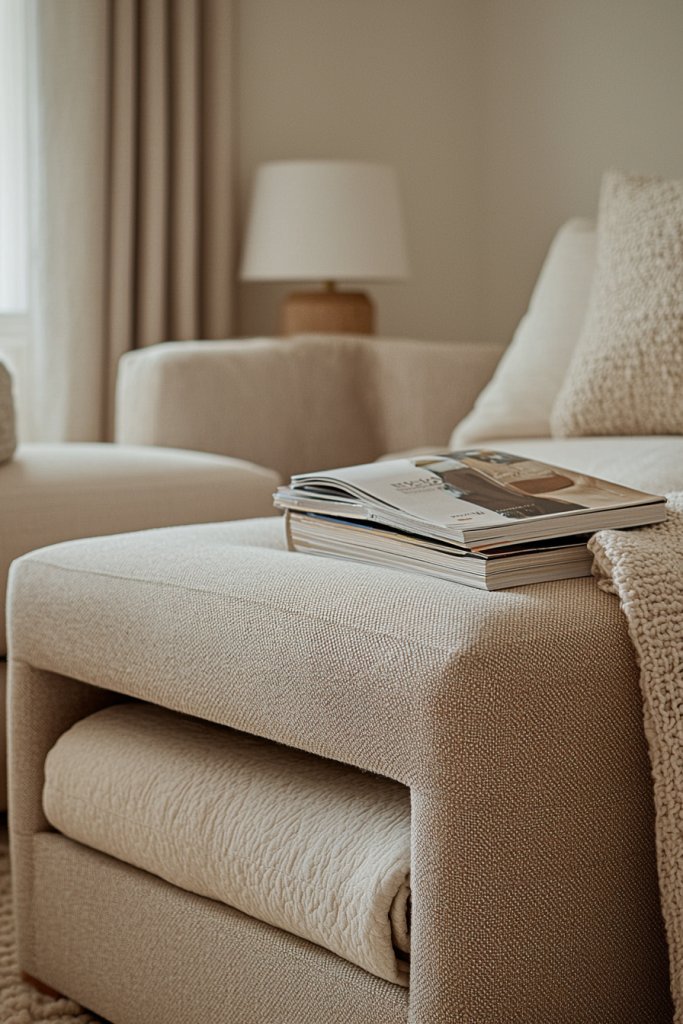
Maximizing space without sacrificing style is a core principle in Japandi design, and multi-functional furniture makes this achievable. These versatile pieces help keep surfaces clear, reduce clutter, and add convenience, especially in smaller spaces.
Picture a cozy living corner with a storage ottoman in warm beige fabric that doubles as seating and hidden storage for blankets and magazines. In a bedroom, a fold-away desk can be tucked behind a sliding panel or wall, ready to be pulled out for work or hobbies, then neatly stowed away to maintain serenity.
A bed with built-in drawers or a sofa bed provides extra storage and flexibility. These furniture choices keep clutter out of sight, making the room feel more expansive and calm.
They also promote a minimalist lifestyle by reducing the need for multiple pieces. To incorporate multi-functional furniture, look for Scandinavian-inspired designs or custom DIY options.
Focus on items with clean lines and natural finishes—like light wood or matte black metal—to maintain the minimalist aesthetic. Essential pieces include storage beds, benches with hidden compartments, and nested tables that can serve multiple purposes.
Keep the overall layout simple, ensuring each piece has a clear role in supporting both function and style. This approach allows you to enjoy a clutter-free, serene space that adapts to your daily needs effortlessly.
5. Incorporate Textured Textiles for Warmth and Visual Interest
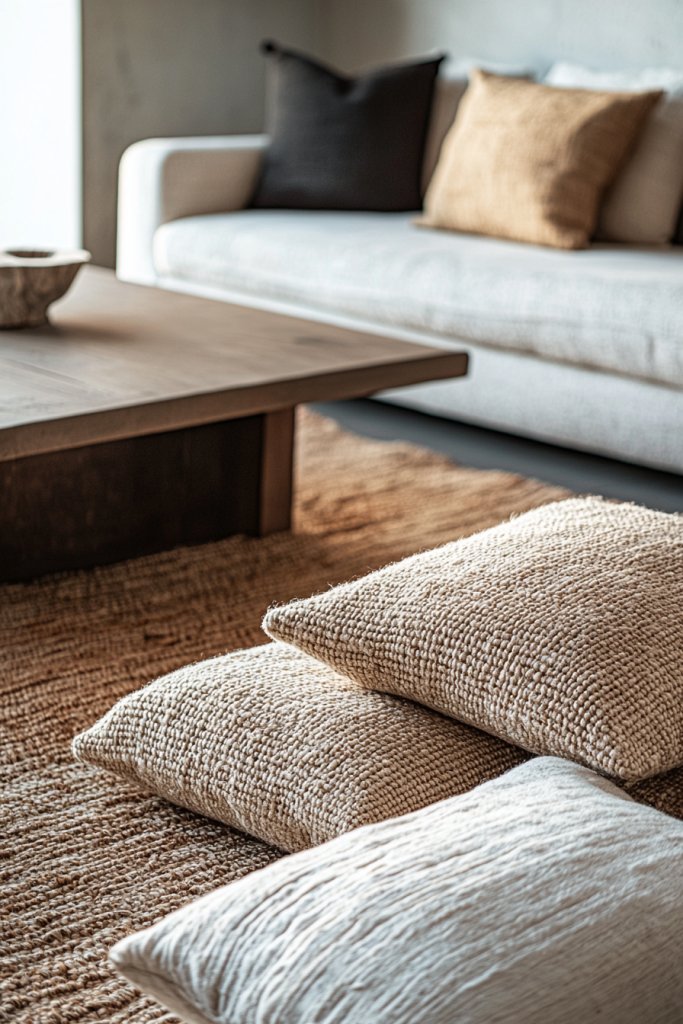
Adding textured textiles is a simple yet powerful way to infuse warmth and depth into a Japandi space without creating clutter. Think of a soft, cream-colored throw blanket with chunky knit texture draped casually over a low sofa or a woven jute rug with subtle ridges that anchor the room.
Cushions in natural fibers like linen, hemp, or boucle in muted earthy tones—warm taupe, sandy beige, or slate gray—offer tactile comfort and visual softness. These textiles create a cozy environment that invites relaxation, engaging the senses through their tactile qualities and subtle variations in pattern and weave.
The gentle contrast between smooth surfaces and textured fabrics helps to maintain the minimalist aesthetic while adding layers of comfort and interest. Visualize walking into a serene living room where the tactile richness of a woven wool cushion complements the matte finish of a wooden coffee table.
A tactile rug underfoot feels warm and inviting, muffling footsteps softly and anchoring the space. The fabrics’ natural scents—like fresh linen or raw wool—further enhance the calming ambiance.
They soften the sharp lines of furniture and balance the starkness of minimal design, making the room feel lived-in yet uncluttered. The textures also serve as subtle focal points that draw the eye and encourage a sense of harmony through their understated elegance.
To incorporate textured textiles, start with a neutral-toned, chunky-knit throw blanket in a natural fiber like cotton or wool—these are easy to find and budget-friendly. Layer in a jute or sisal rug for grounding the space, and add cushions in linen or hemp to soften seating areas.
Mix and match textures but keep the color palette subdued, sticking to earthy neutrals and muted tones. For a quick update, swap out existing cushions or add a tactile throw in your current setup. These simple swaps bring instant warmth and visual interest while maintaining clean, clutter-free aesthetics.
6. Use Sculptural Ceramics and Decorative Objects for Subtle Accents
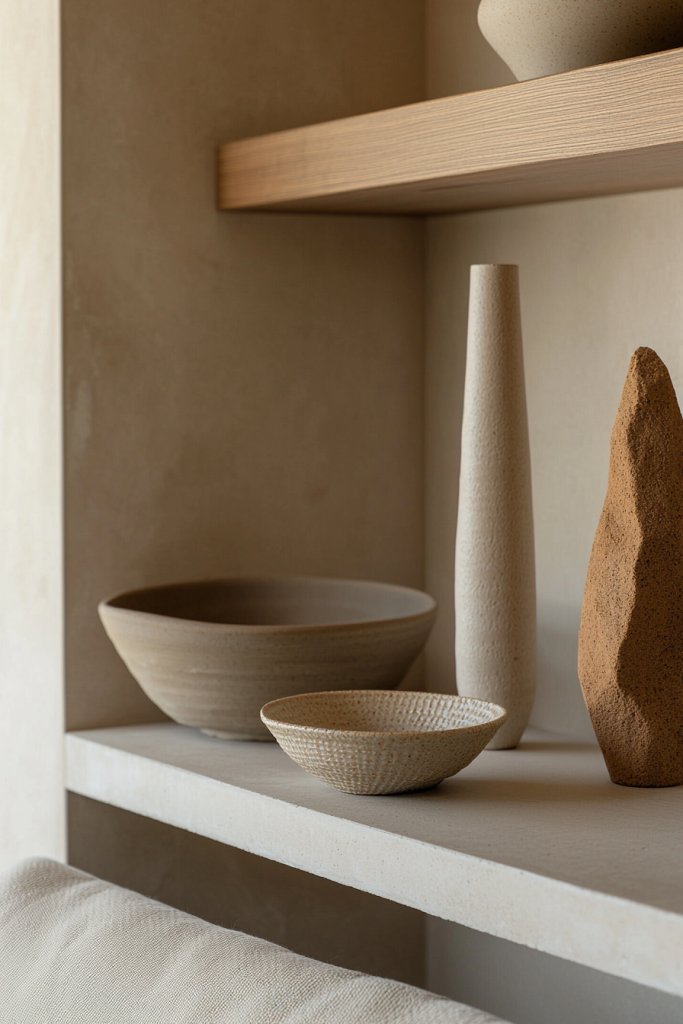
In Japandi interiors, carefully chosen sculptural ceramics and understated decorative objects serve as elegant, low-profile accents that add personality without overwhelming the space. Imagine a sleek, handcrafted vase in matte black or warm terracotta placed on a low shelf or coffee table.
These objects feature simple, organic shapes—rounded, asymmetrical, or geometric—that bring a sense of artistry and craftsmanship. They act as focal points that subtly draw the eye, adding visual interest through their form and texture without cluttering the scene.
The emphasis is on quality and simplicity, making each piece feel intentional and special. Picture a minimalist shelf displaying a few carefully curated ceramics: a small, sculptural bowl with a textured glaze, a tall slender vase with clean lines, and a sculptural sculpture in natural clay.
These objects evoke a sense of calm and understated elegance, their muted colors and tactile surfaces contrasting beautifully with soft textiles or natural wood furniture. They add layers of visual depth and personality while maintaining the calm, uncluttered vibe characteristic of Japandi design.
The key is restraint—selecting a handful of meaningful objects that enhance the overall harmony of the space. To incorporate these accents, look for handcrafted ceramics at local artisans or online stores specializing in minimalist decor.
Opt for pieces in neutral tones like beige, gray, or black, with matte or textured finishes. Place them thoughtfully on open shelves, sideboards, or coffee tables, ensuring they are spaced out to avoid visual clutter.
If you’re on a budget, repurpose existing ceramics or DIY simple clay pieces. Focus on quality over quantity, and let each object serve as a subtle yet impactful detail that elevates your space’s serenity and sophistication.
7. Integrate Low-Profile Furniture for a Spacious Feel
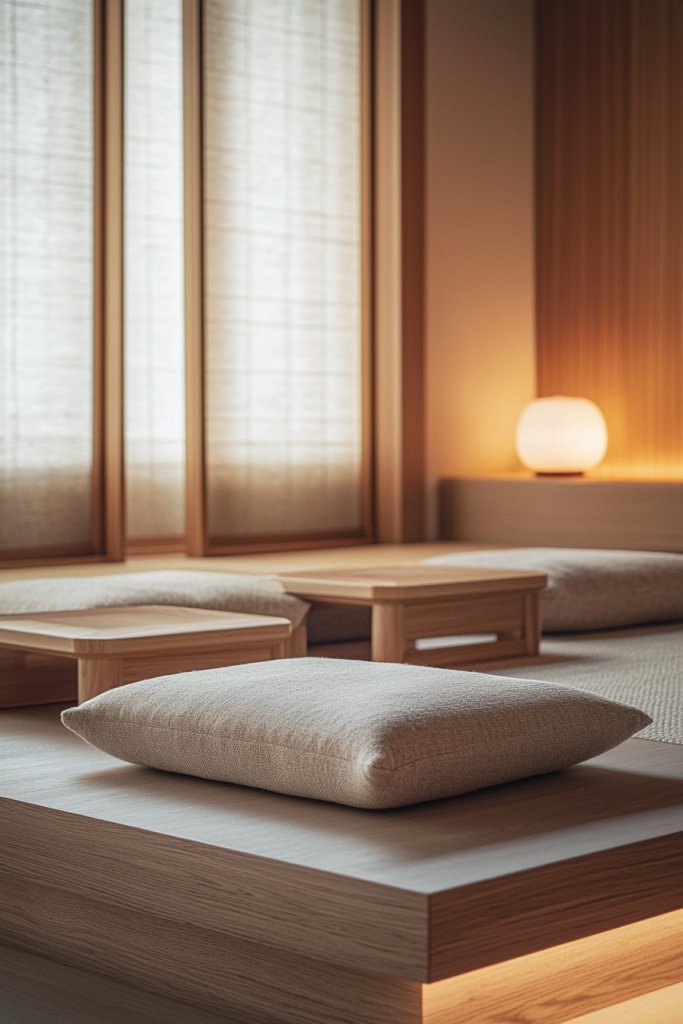
Low-profile furniture is a hallmark of Japandi style that enhances the sense of openness and tranquility in a room. Picture a low, wide sofa in soft beige linen fabric with slim wooden legs, positioned close to the floor to create a grounded, cozy seating area.
A low coffee table made of natural wood with clean lines complements the arrangement without blocking sightlines or crowding the space. Beds with a low frame or platform design, paired with simple bedding, further emphasize a sense of calm and spaciousness.
These pieces keep the room feeling airy, uncluttered, and easy to navigate. Visualize the room with furniture that rests just above the floor, allowing more visual space between objects and walls.
The low furniture also encourages a relaxed posture and a sense of grounded comfort. The natural materials—light wood, soft textiles—enhance the warmth, while the minimalist design keeps the look sleek and modern.
These pieces often feature slim profiles and subtle details, which avoid visual heaviness and foster a serene environment where the focus is on quality and harmony. To incorporate low-profile furniture, choose a sofa or bed with a simple wooden frame in a natural finish.
Look for options with sleek, unobtrusive legs or a platform design that sits close to the ground. For a quick update, consider replacing your current furniture with more streamlined, low-slung alternatives, or add a low coffee table in a similar style. Keep the space uncluttered by pairing these pieces with open space and minimal accessories, creating a visually calming environment that feels both spacious and welcoming.
8. Utilize Sliding Doors and Foldable Partitions to Create Flexible Spaces
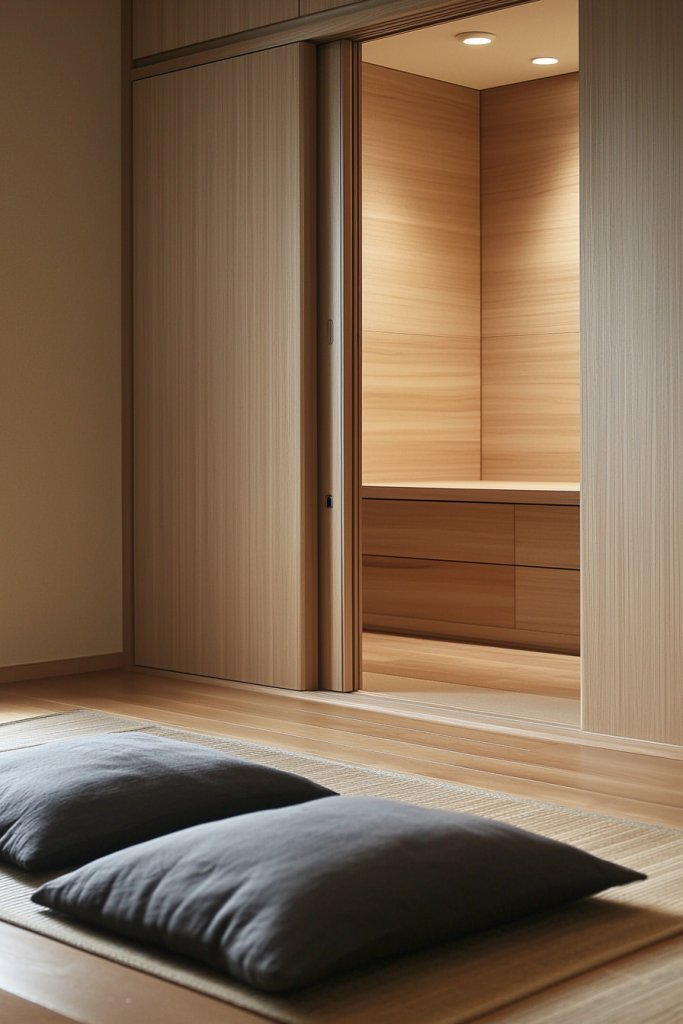
Sliding doors and foldable partitions are practical solutions that enhance flexibility and minimize clutter in a Japandi interior. Imagine a room with a sleek, matte black sliding door that seamlessly glides open to reveal an adjoining space or closet, eliminating the need for bulky swinging doors.
Alternatively, a foldable shoji screen made of light wood and translucent paper can divide a space temporarily, allowing you to open or close areas as needed. These features help maintain an open, airy atmosphere while providing the option to create privacy or define zones without adding visual bulk.
Visualize the transformation: when open, the space feels expansive and connected, with clean lines and unobstructed views. When closed, the partition subtly creates a sense of separation—perfect for a meditation corner or workspace—without sacrificing the minimalist aesthetic.
The smooth movement of sliding or folding elements enhances the sense of calm and order, reducing visual clutter and making the space adaptable to different needs throughout the day. These elements can be integrated into cabinetry or doorways, blending seamlessly with the overall design.
To implement, start with a simple, pre-made sliding door kit in a neutral tone like black, gray, or wood finish. For partitions, lightweight shoji screens or fabric-covered foldable panels work well and are easy to set up.
Measure your space carefully and choose a system that fits your opening or room size. Installing a sliding track or hinge mechanism is straightforward—many tutorials are available online, and basic DIY skills are sufficient. These flexible solutions allow your space to evolve effortlessly, maximizing function while keeping your environment calm and uncluttered.
9. Add Understated Lighting for Soft, Ambient Glow

Lighting plays a crucial role in creating a serene, clutter-free Japandi space, and understated fixtures help achieve a soft, ambient glow. Think of a minimalist pendant light with a matte black or natural wood finish hanging gently over a dining or reading nook, casting warm, diffuse light that soothes the senses.
Concealed LED strip lighting behind shelves or under cabinets adds a gentle glow without visual distraction. Table lamps with simple, organic shapes and fabric shades in muted tones can also enhance the calming atmosphere while serving as functional accents.
Visualize a room softly illuminated by layered lighting sources: the warm glow of a pendant, the subtle shine of a ceramic table lamp, and hidden LED strips that wash walls with gentle light. The lighting’s warm color temperature (around 2700K) mimics natural sunset hues, enhancing the cozy, inviting feel.
The focus is on creating an environment where light enhances relaxation, not harsh overhead bulbs or bright fluorescents, which can disrupt the peaceful vibe. Thoughtful placement of lighting fixtures highlights textures and materials, amplifying the room’s natural beauty.
To incorporate understated lighting, start with a simple pendant or wall-mounted fixture in neutral finishes like black, brushed brass, or natural wood. Add a soft-textured lampshade for warmth, or install dimmable LED strips to customize brightness.
Use timers or smart lighting for convenience and energy efficiency. Position lights thoughtfully to avoid cluttered cords and ensure they highlight key areas—such as seating, beds, or shelves—without overwhelming the space. This subtle approach to lighting elevates your room’s tranquility and overall aesthetic.
10. Design with Clutter-Free Entryways Using Hooks and Benches
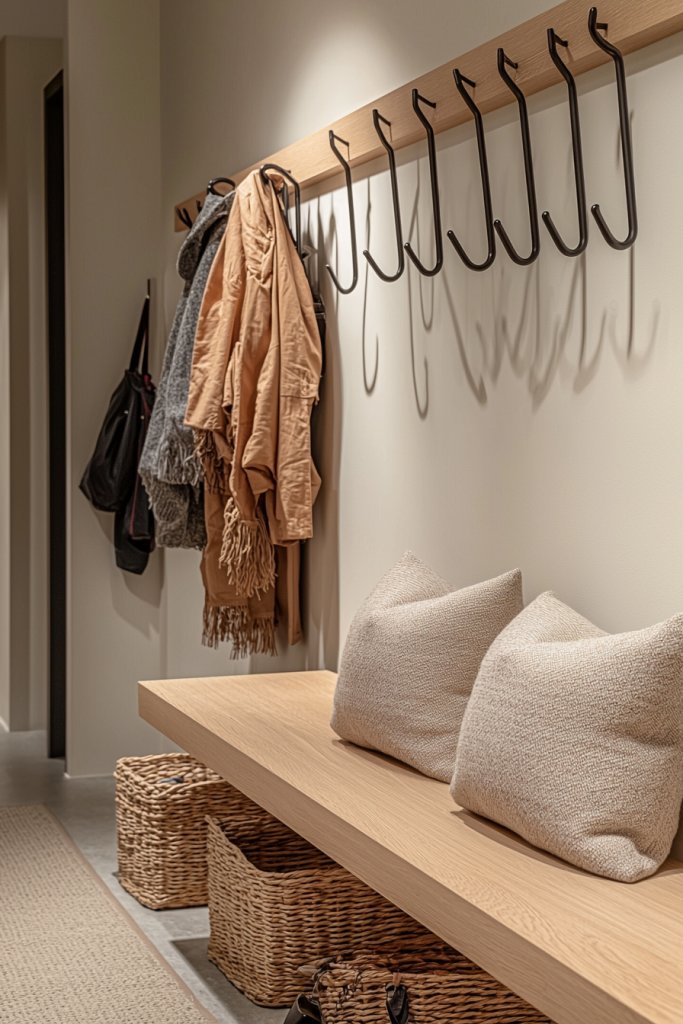
A tidy entryway sets the tone for a serene home, making organization both practical and visually appealing. When done right, it transforms a chaotic space into a calm, welcoming zone that instantly reflects the Japandi aesthetic.
Imagine a sleek, narrow hallway with a minimalist wooden bench in a light oak finish, topped with a soft, neutral-toned cushion — perhaps in a beige or muted gray. Above, a row of thin, black metal hooks holds coats, bags, and scarves in an orderly fashion.
A couple of woven baskets underneath provide discreet storage for shoes, while a simple, low-profile mirror completes the look. The overall scene feels uncluttered, with natural textures and clean lines that encourage a sense of calm and purposeful simplicity.
The space smells fresh from a hint of linen spray, and the quiet organization invites a peaceful start to the day. To recreate this look, start with a slim, wooden bench—preferably in light or natural wood like ash or birch—and add a soft cushion in a neutral fabric.
Install a few slim hooks or pegs above the bench, choosing matte black or brushed metal for a modern touch. Use decorative baskets or shoe trays beneath the bench for hidden storage.
Keep surfaces free of excess decor, and choose a mirror that complements the minimalist vibe. This setup is straightforward to assemble and can be customized with your preferred storage accessories, making your entryway both functional and beautifully uncluttered.
11. Incorporate Natural Materials for a Warm, Harmonious Atmosphere
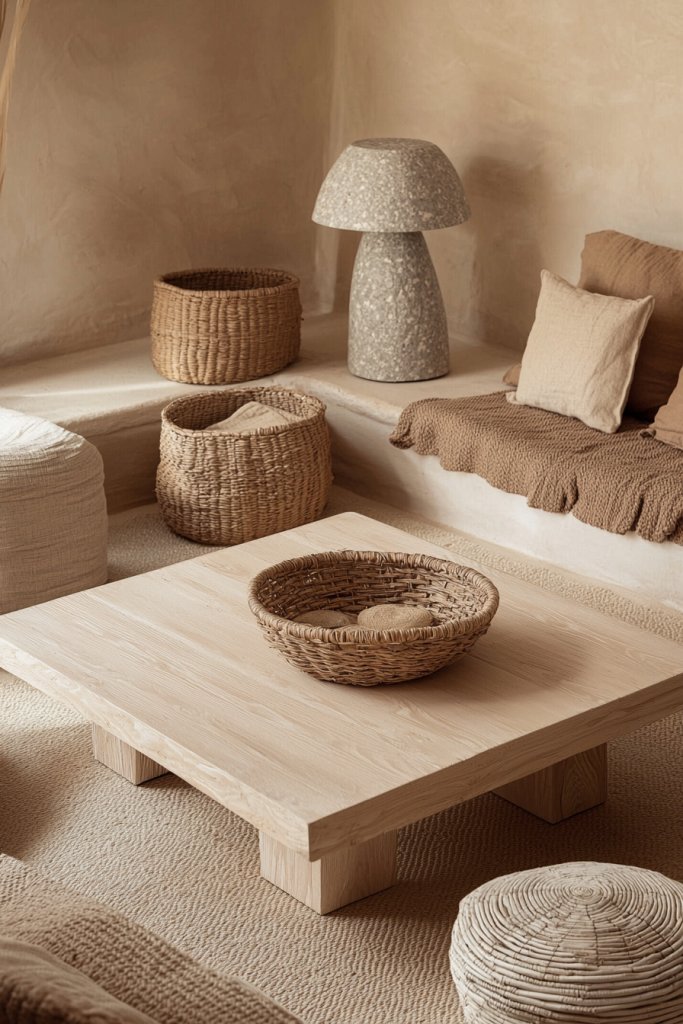
Bringing natural materials into your space instantly creates a warm, grounded environment that embodies the Japandi style’s balance of simplicity and serenity. These elements add tactile richness and visual harmony, making your home feel inviting and peaceful.
Visualize a living room with a low, wooden coffee table crafted from light, unfinished oak, paired with woven rattan baskets and a stone accent lamp. Soft wool or linen throws in earthy tones drape over neutral-colored cushions, while a bamboo or jute rug cushions your feet with natural texture.
The scent of cedar or sandalwood subtly wafts through the air, reinforcing the connection to nature. The combination of wood grains, woven fibers, and stone surfaces creates a layered, tactile experience that feels both cozy and sophisticated, emphasizing harmony with the natural world.
To incorporate these materials, choose furniture made from light-colored woods such as ash, beech, or oak. Add textiles like bamboo blinds, linen curtains, or jute rugs, and accessorize with ceramic or stone decor pieces.
For a budget-friendly option, consider sourcing secondhand or sustainable options from local artisans or eco-conscious brands. Minimal maintenance is key—simply dust or wipe down surfaces regularly to keep the natural textures fresh and vibrant. This approach not only enhances aesthetic appeal but also fosters a tranquil, eco-friendly atmosphere.
12. Keep Surfaces Clear with Thoughtful Decorative Storage
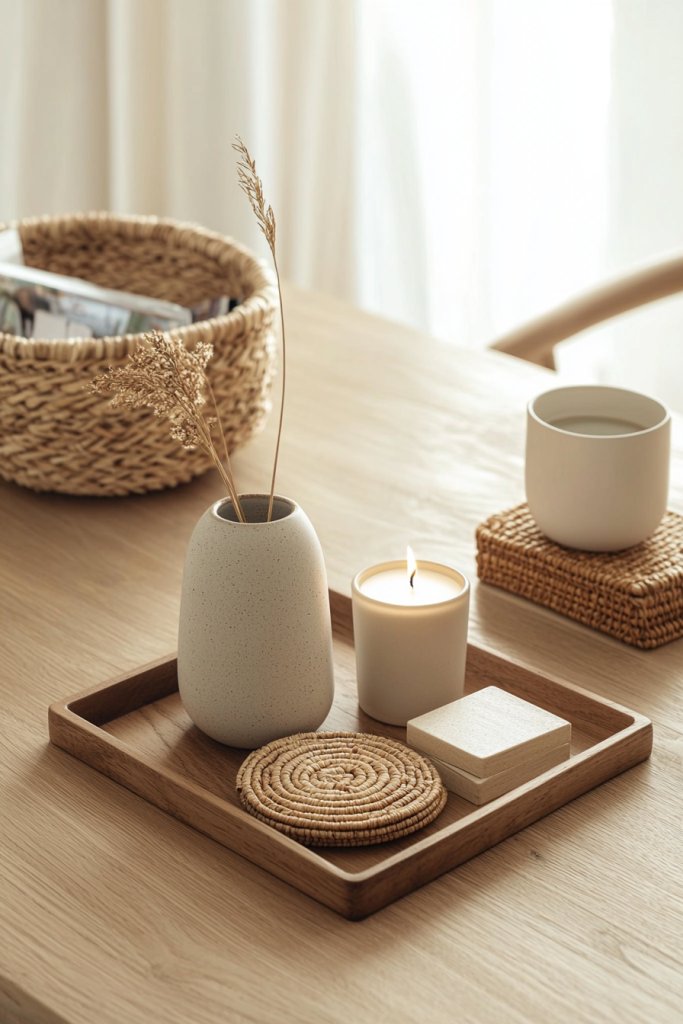
Cluttered surfaces disrupt the calming flow of a Japandi-inspired space, so thoughtful storage solutions are essential to maintain serenity. By combining practicality with aesthetic appeal, you can keep everyday items organized and visually pleasing.
Picture a dining table or coffee station with a sleek, wooden tray holding a few carefully selected objects — perhaps a ceramic vase, a small candle, and a woven coaster. Nearby, a woven or rattan basket serves as a stylish container for magazines or miscellaneous clutter.
Use decorative boxes or shallow ceramic bowls on side tables to corral keys, remotes, or small accessories, keeping surfaces tidy without sacrificing style. The overall effect is a balanced, organized space where every item has a designated place, reducing visual noise and allowing your decor pieces to stand out.
To implement this, invest in a few decorative storage options like woven baskets, ceramic trays, or wooden boxes in neutral tones. Keep surfaces minimally decorated—choose only a few functional items to display—and regularly declutter.
Use matching or complementary materials to unify the aesthetic, and consider labeling or stacking containers for easy access. This simple yet effective strategy helps your home stay serene and clutter-free, making daily routines smoother and more enjoyable.
13. Install Floor-to-Ceiling Windows for Bright, Airy Spaces

Maximizing natural light is a cornerstone of Japandi design, creating a luminous, airy environment that promotes calm and clarity. Floor-to-ceiling windows serve as a striking feature that visually expands your space and connects indoors with the outdoors.
Imagine a living room bathed in soft daylight, where expansive glass panes frame views of a tranquil garden or landscape. The light floods the space, illuminating neutral walls and highlighting natural materials like wood and stone.
The windows are unobstructed, with slim, black metal frames that add a modern, minimalist touch. During the day, the room feels open and invigorating, and at dusk, the gentle glow enhances the peaceful atmosphere.
The overall mood is one of effortless serenity, with the interplay of light and space inviting calm and mindfulness. To achieve this, consider installing large, floor-to-ceiling windows with simple, unobtrusive frames—metal or slim wood are ideal choices.
Use sheer, light-colored curtains or blinds that can be drawn for privacy without blocking daylight. Keep furniture low and minimal to avoid obstructing views, and choose light, neutral wall colors to reflect the natural light. This investment transforms your space into a bright, tranquil haven that feels expansive and connected to nature, enriching your daily life.
14. Use Geometric Patterns and Subtle Textures for Visual Calm
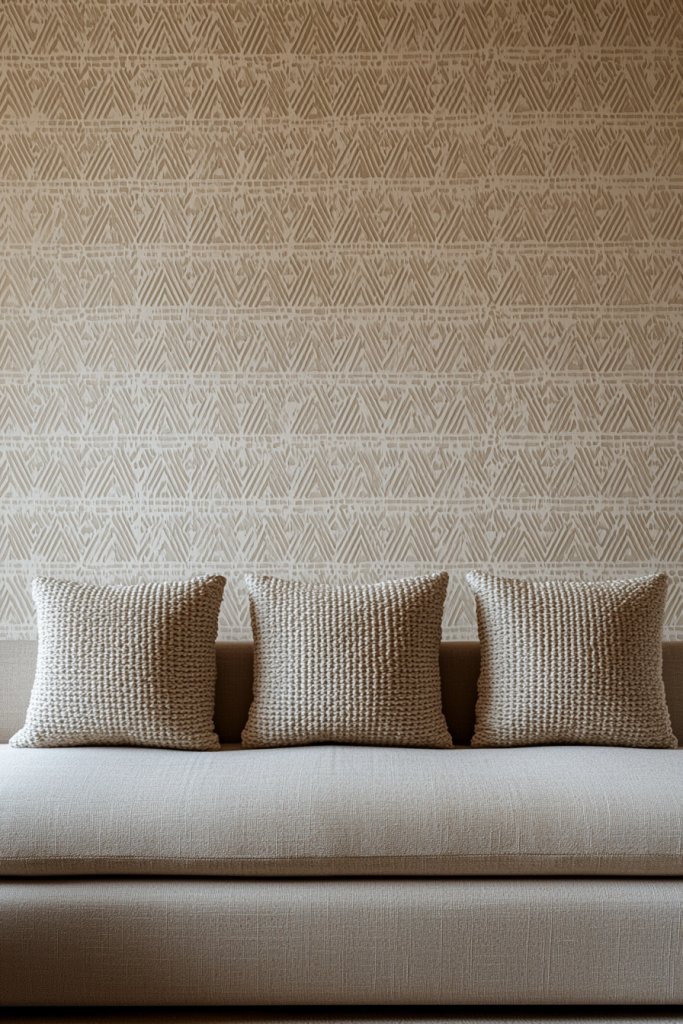
Incorporating geometric patterns and subtle textures into your Japandi space creates a soothing visual rhythm that enhances serenity while adding just enough detail to keep the environment interesting. This approach balances simplicity with sophistication, making your interior feel thoughtfully curated and calming at the same time.
Imagine a neutral-colored sofa upholstered in a soft, woven fabric featuring delicate, understated geometric quilting. Complement this with throw pillows that have subtle embossed patterns in shades of beige, taupe, or muted gray.
The walls might be adorned with textured wallpaper or tiles showcasing faint, geometric lines, which catch the light gently and add depth without overwhelming the senses. The overall effect is a balanced interplay of clean shapes and tactile interest—think soft linen, smooth ceramics, and matte finishes—that invites touch and visual calm.
The space feels harmonious, with each element contributing to a peaceful, cohesive atmosphere. To create this look, start with a neutral base: opt for a light, warm palette like cream, blush, or charcoal.
Use textiles such as linen or wool for cushions and throws that feature subtle patterns or textures. Incorporate geometric accents through rugs, wall tiles, or decorative ceramics—these can be DIY painted or sourced from affordable home decor stores.
Keep decorations minimal, focusing on high-quality pieces that add visual interest without clutter. Combining these elements thoughtfully will result in a tranquil environment that feels both modern and timeless.
Conclusion
Embracing Japandi interior design offers a beautiful balance of minimalism, warmth, and tranquility that transforms any space into a peaceful retreat. By incorporating hidden storage, neutral palettes, multi-functional furniture, and natural materials, you can create a clutter-free environment that maximizes serenity.
Don’t hesitate to experiment with these ideas—your harmonious, stylish home is within reach. Start today and cultivate a sanctuary of calm and clarity that truly reflects the essence of Japandi living.
Leave a Reply